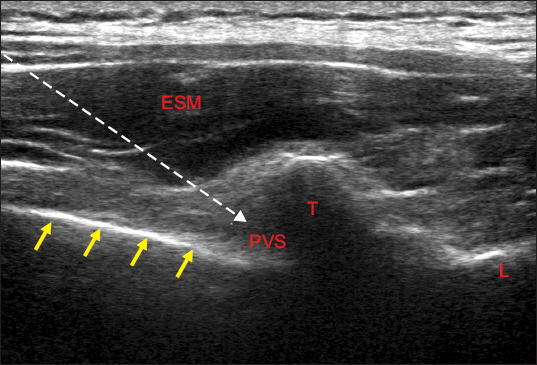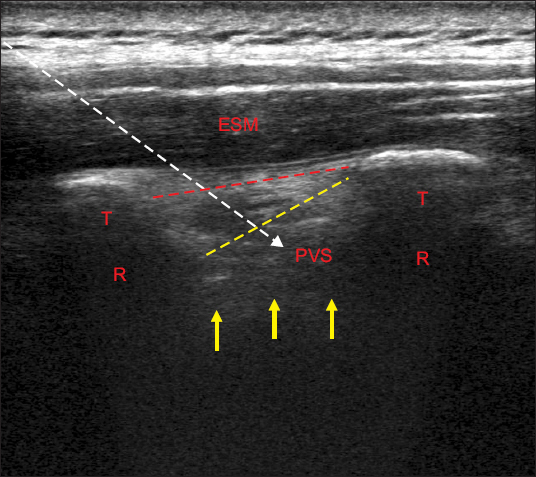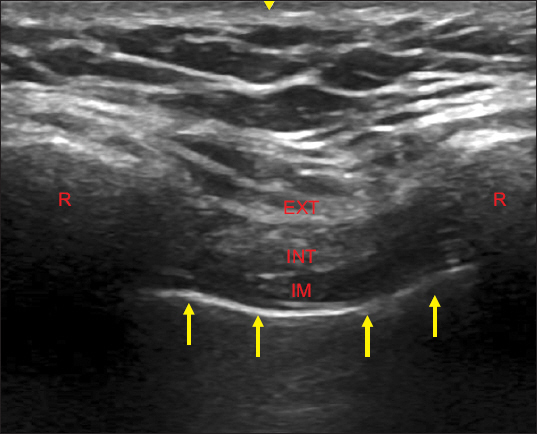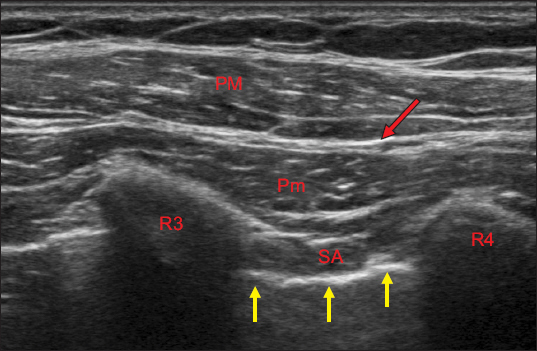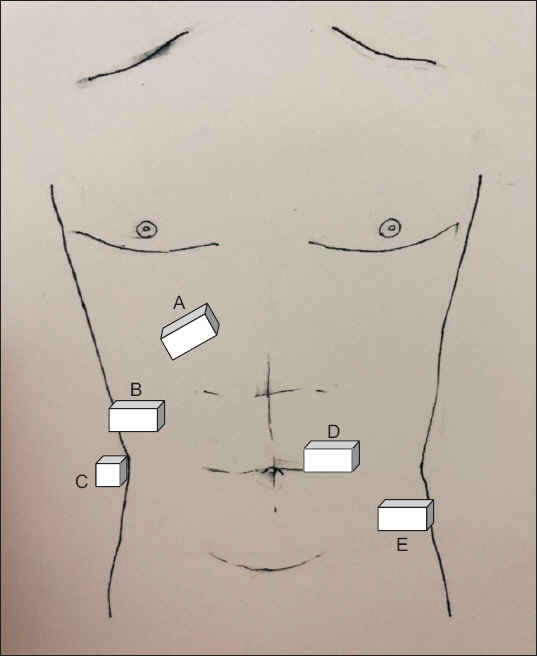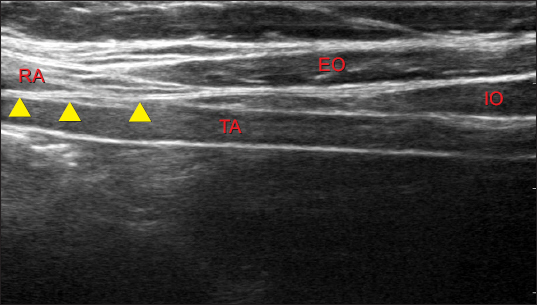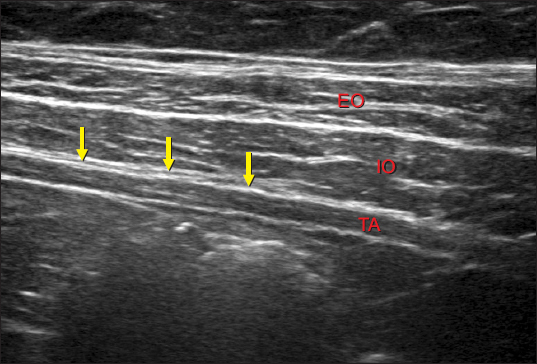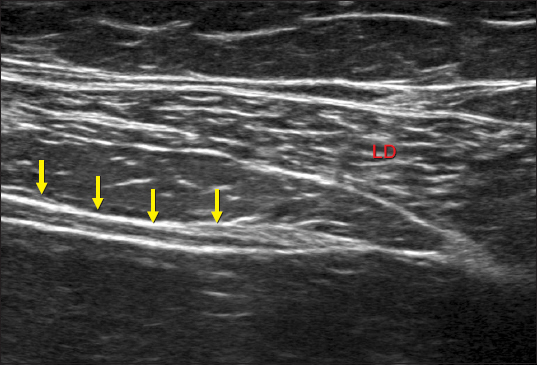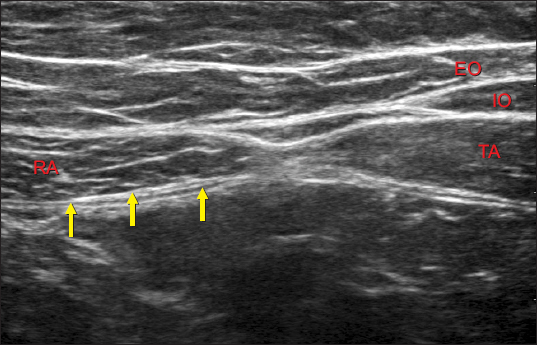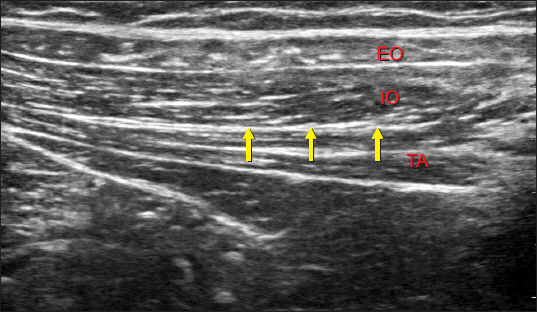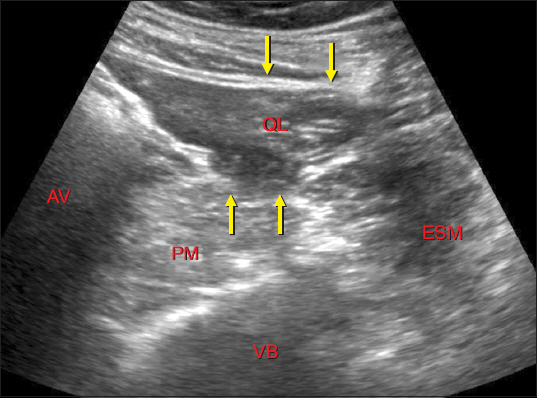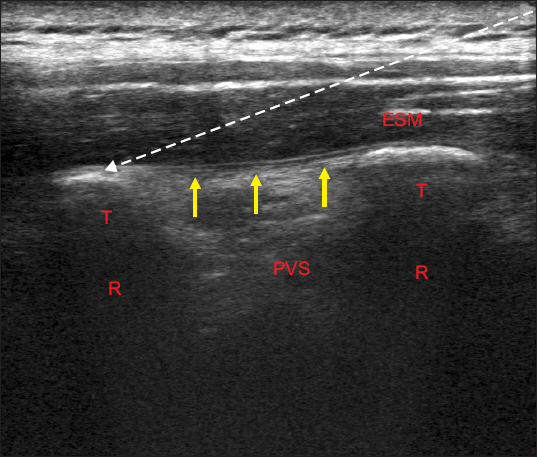Anesth Pain Med.
2018 Apr;13(2):128-142. 10.17085/apm.2018.13.2.128.
Ultrasound-guided truncal blocks for perioperative analgesia
- Affiliations
-
- 1Department of Anesthesiology and Pain Medicine, Asan Medical Center, University of Ulsan College of Medicine, Seoul, Korea. koh9726@naver.com
- KMID: 2437418
- DOI: http://doi.org/10.17085/apm.2018.13.2.128
Abstract
- The widespread application of ultrasound in clinical anesthesiology has led to an increase in the number of practitioners performing peripheral nerve blocks of the trunk to produce analgesia and anesthesia for surgeries involving the thorax, abdomen, and lower extremities. The use of real-time ultrasound has allowed the peripheral nerves, planes, and plexuses of the trunk to be located more accurately and has improved the success rate of blocks. Compared to central neuraxial techniques, many types of truncal blocks are relatively easy to perform and have low side effect profiles. As a result, truncal blocks have been introduced to provide perioperative analgesia for surgeries involving the thorax and abdomen. The most frequently used truncal block techniques include the paravertebral block, intercostal block, pectoralis and serratus anterior block, rectus sheath block, transversus abdominis plane block, and ilioinguinal and iliohypogastric nerve blocks. Recently introduced techniques also include the quadratus lumborum and erector spinae plane blocks. To apply each block correctly and reduce the likelihood of related side effects and complications, the practitioner must have a thorough understanding of the anatomical region, optimal block positioning, and device selection and management.
Keyword
MeSH Terms
Figure
Cited by 1 articles
-
Current evidence of ultrasound-guided fascial plane blocks for cardiac surgery: a narrative literature review
Boohwi Hong, Chahyun Oh, Yumin Jo, Soomin Lee, Seyeon Park, Yoon-Hee Kim
Korean J Anesthesiol. 2022;75(6):460-472. doi: 10.4097/kja.22564.
Reference
-
1. Finnerty O, Carney J, McDonnell JG. Trunk blocks for abdominal surgery. Anaesthesia. 2010; 65(Suppl1):76–83. DOI: 10.1111/j.1365-2044.2009.06203.x. PMID: 20377549.2. Niraj G, Kelkar A, Hart E, Horst C, Malik D, Yeow C, et al. Comparison of analgesic efficacy of four-quadrant transversus abdominis plane (TAP) block and continuous posterior TAP analgesia with epidural analgesia in patients undergoing laparoscopic colorectal surgery: an open-label, randomised, non-inferiority trial. Anaesthesia. 2014; 69:348–55. DOI: 10.1111/anae.12546. PMID: 24641640.3. Niraj G, Kelkar A, Jeyapalan I, Graff-Baker P, Williams O, Darbar A, et al. Comparison of analgesic efficacy of subcostal transversus abdominis plane blocks with epidural analgesia following upper abdominal surgery. Anaesthesia. 2011; 66:465–71. DOI: 10.1111/j.1365-2044.2011.06700.x. PMID: 21457153.4. Yeung JH, Gates S, Naidu BV, Wilson MJ, Gao Smith F. Paravertebral block versus thoracic epidural for patients undergoing thoracotomy. Cochrane Database Syst Rev. 2016; 2:CD009121. DOI: 10.1002/14651858.CD009121.pub2.5. Ding X, Jin S, Niu X, Ren H, Fu S, Li Q. A comparison of the analgesia efficacy and side effects of paravertebral compared with epidural blockade for thoracotomy: an updated meta-analysis. PLoS One. 2014; 9:e96233. DOI: 10.1371/journal.pone.0096233. PMID: 24797238. PMCID: PMC4010440.6. Wilson SH, Wolf BJ, Algendy AA, Sealy C, Demos HA, McSwain JR. Comparison of lumbar epidurals and lumbar plexus nerve blocks for analgesia following primary total hip arthroplasty: a retrospective analysis. J Arthroplasty. 2017; 32:635–40. DOI: 10.1016/j.arth.2016.07.042. PMID: 27597428.7. Karmakar MK. Thoracic paravertebral block. Anesthesiology. 2001; 95:771–80. DOI: 10.1097/00000542-200109000-00033. PMID: 11575553.8. Luyet C, Eichenberger U, Greif R, Vogt A, Szücs Farkas Z, Moriggl B. Ultrasound-guided paravertebral puncture and placement of catheters in human cadavers: an imaging study. Br J Anaesth. 2009; 102:534–9. DOI: 10.1093/bja/aep015. PMID: 19244265.9. Hara K, Sakura S, Nomura T, Saito Y. Ultrasound-guided thoracic paravertebral block in breast surgery. Anaesthesia. 2009; 64:223–5. DOI: 10.1111/j.1365-2044.2008.05843.x. PMID: 19143711.10. Shibata Y, Nishiwaki K. Ultrasound-guided intercostal approach to thoracic paravertebral block. Anesth Analg. 2009; 109:996–7. DOI: 10.1213/ane.0b013e3181af7e7b. PMID: 19690285.11. Ben-Ari A, Moreno M, Chelly JE, Bigeleisen PE. Ultrasound-guided paravertebral block using an intercostal approach. Anesth Analg. 2009; 109:1691–4. DOI: 10.1213/ANE.0b013e3181b72d50. PMID: 19843811.12. Eason MJ, Wyatt R. Paravertebral thoracic block-a reappraisal. Anaesthesia. 1979; 34:638–42. DOI: 10.1111/j.1365-2044.1979.tb06363.x.13. Bouman EAC, Sieben JM, Balthasar AJR, Joosten EA, Gramke HF, van Kleef M, et al. Boundaries of the thoracic paravertebral space: potential risks and benefits of the thoracic paravertebral block from an anatomical perspective. Surg Radiol Anat. 2017; 39:1117–25. DOI: 10.1007/s00276-017-1857-4. PMID: 28444433. PMCID: PMC5610675.14. D'Ercole F, Arora H, Kumar PA. Paravertebral block for thoracic surgery. J Cardiothorac Vasc Anesth. 2018; 32:915–27. DOI: 10.1053/j.jvca.2017.10.003. PMID: 29169795.15. Cowie B, McGlade D, Ivanusic J, Barrington MJ. Ultrasound-guided thoracic paravertebral blockade: a cadaveric study. Anesth Analg. 2010; 110:1735–9. DOI: 10.1213/ANE.0b013e3181dd58b0. PMID: 20435949.16. Krediet AC, Moayeri N, van Geffen GJ, Bruhn J, Renes S, Bigeleisen PE, et al. Different approaches to ultrasound-guided thoracic paravertebral block: an illustrated review. Anesthesiology. 2015; 123:459–74. DOI: 10.1097/ALN.0000000000000747. PMID: 26083767.17. Saito T, Den S, Cheema SP, Tanuma K, Carney E, Carlsson C, et al. A single-injection, multi-segmental paravertebral block-extension of somatosensory and sympathetic block in volunteers. Acta Anaesthesiol Scand. 2001; 45:30–3. DOI: 10.1034/j.1399-6576.2001.450105.x. PMID: 11152029.18. Renes SH, Bruhn J, Gielen MJ, Scheffer GJ, van Geffen GJ. In-plane ultrasound-guided thoracic paravertebral block: a preliminary report of 36 cases with radiologic confirmation of catheter position. Reg Anesth Pain Med. 2010; 35:212–6. DOI: 10.1097/AAP.0b013e3181c75a8b. PMID: 20301827.19. Kotzé A, Scally A, Howell S. Efficacy and safety of different techniques of paravertebral block for analgesia after thoracotomy: a systematic review and metaregression. Br J Anaesth. 2009; 103:626–36. DOI: 10.1093/bja/aep272. PMID: 19837806.20. Joshi GP, Bonnet F, Shah R, Wilkinson RC, Camu F, Fischer B, et al. A systematic review of randomized trials evaluating regional techniques for postthoracotomy analgesia. Anesth Analg. 2008; 107:1026–40. DOI: 10.1213/01.ane.0000333274.63501.ff. PMID: 18713924.21. Davies RG, Myles PS, Graham JM. A comparison of the analgesic efficacy and side-effects of paravertebral vs epidural blockade for thoracotomy--a systematic review and meta-analysis of randomized trials. Br J Anaesth. 2006; 96:418–26. DOI: 10.1093/bja/ael020. PMID: 16476698.22. Scarci M, Joshi A, Attia R. In patients undergoing thoracic surgery is paravertebral block as effective as epidural analgesia for pain management? Interact Cardiovasc Thorac Surg. 2010; 10:92–6. DOI: 10.1510/icvts.2009.221127. PMID: 19854794.23. Bhatia A, Gofeld M, Ganapathy S, Hanlon J, Johnson M. Comparison of anatomic landmarks and ultrasound guidance for intercostal nerve injections in cadavers. Reg Anesth Pain Med. 2013; 38:503–7. DOI: 10.1097/AAP.0000000000000006. PMID: 24121611.24. Woodworth GE, Ivie RMJ, Nelson SM, Walker CM, Maniker RB. Perioperative breast analgesia: a qualitative review of anatomy and regional techniques. Reg Anesth Pain Med. 2017; 42:609–31. DOI: 10.1097/AAP.0000000000000641. PMID: 28820803.25. Chakraborty A, Khemka R, Datta T. Ultrasound-guided truncal blocks: a new frontier in regional anaesthesia. Indian J Anaesth. 2016; 60:703–11. DOI: 10.4103/0019-5049.191665. PMID: 27761032. PMCID: PMC5064693.26. Byas-Smith MG, Gulati A. Ultrasound-guided intercostal nerve cryoablation. Anesth Analg. 2006; 103:1033–5. DOI: 10.1213/01.ane.0000237290.68166.c2. PMID: 17000825.27. Ozkan D, Akkaya T, Karakoyunlu N, Arik E, Ergil J, Koc Z, et al. Effect of ultrasound-guided intercostal nerve block on postoperative pain after percutaneous nephrolithotomy: prospective randomized controlled study. Anaesthesist. 2013; 62:988–94. DOI: 10.1007/s00101-013-2253-z. PMID: 24173546.28. Shanti CM, Carlin AM, Tyburski JG. Incidence of pneumothorax from intercostal nerve block for analgesia in rib fractures. J Trauma. 2001; 51:536–9. DOI: 10.1097/00005373-200109000-00019.29. Blanco R. The 'pecs block': a novel technique for providing analgesia after breast surgery. Anaesthesia. 2011; 66:847–8. DOI: 10.1111/j.1365-2044.2011.06838.x. PMID: 21831090.30. Blanco R, Fajardo M, Parras Maldonado T. Ultrasound description of Pecs II (modified Pecs I): a novel approach to breast surgery. Rev Esp Anestesiol Reanim. 2012; 59:470–5. DOI: 10.1016/j.redar.2012.07.003. PMID: 22939099.31. Blanco R, Parras T, McDonnell JG, Prats-Galino A. Serratus plane block: a novel ultrasound-guided thoracic wall nerve block. Anaesthesia. 2013; 68:1107–13. DOI: 10.1111/anae.12344. PMID: 23923989.32. de la Torre PA, Garcia PD, Alvarez SL, Miguel FJ, Perez MF. A novel ultrasound-guided block: a promising alternative for breast analgesia. Aesthet Surg J. 2014; 34:198–200. DOI: 10.1177/1090820X13515902. PMID: 24396082.33. Ueshima H, Otake H. Addition of transversus thoracic muscle plane block to pectoral nerves block provides more effective perioperative pain relief than pectoral nerves block alone for breast cancer surgery. Br J Anaesth. 2017; 118:439–43. DOI: 10.1093/bja/aew449. PMID: 28203723.34. Ueshima H, Kitamura A. Blocking of multiple anterior branches of intercostal nerves (Th2–6) using a transversus thoracic muscle plane block. Reg Anesth Pain Med. 2015; 40:388. DOI: 10.1097/AAP.0000000000000245. PMID: 26079353.35. Kamiya Y, Hasegawa M, Yoshida T, Takamatsu M, Koyama Y. Impact of pectoral nerve block on postoperative pain and quality of recovery in patients undergoing breast cancer surgery: a randomised controlled trial. Eur J Anaesthesiol. 2018; 35:215–23. PMID: 29227351.36. Bashandy GM, Abbas DN. Pectoral nerves I and II blocks in multimodal analgesia for breast cancer surgery: a randomized clinical trial. Reg Anesth Pain Med. 2015; 40:68–74. DOI: 10.1097/AAP.0000000000000163. PMID: 25376971.37. Kulhari S, Bharti N, Bala I, Arora S, Singh G. Efficacy of pectoral nerve block versus thoracic paravertebral block for postoperative analgesia after radical mastectomy: a randomized controlled trial. Br J Anaesth. 2016; 117:382–6. DOI: 10.1093/bja/aew223. PMID: 27543533.38. Syal K, Chandel A. Comparison of the post-operative analgesic effect of paravertebral block, pectoral nerve block and local infiltration in patients undergoing modified radical mastectomy: a randomised double-blind trial. Indian J Anaesth. 2017; 61:643–8. DOI: 10.4103/ija.IJA_81_17. PMID: 28890559. PMCID: PMC5579854.39. Ueshima H, Otake H. Ultrasound-guided pectoral nerves (PECS) block: complications observed in 498 consecutive cases. J Clin Anesth. 2017; 42:46. DOI: 10.1016/j.jclinane.2017.08.006. PMID: 28802149.40. Rafi AN. Abdominal field block: a new approach via the lumbar triangle. Anaesthesia. 2001; 56:1024–6. DOI: 10.1046/j.1365-2044.2001.02279-40.x. PMID: 11576144.41. McDonnell JG, O'Donnell BD, Farrell T, Gough N, Tuite D, Power C, et al. Transversus abdominis plane block: a cadaveric and radiological evaluation. Reg Anesth Pain Med. 2007; 32:399–404. DOI: 10.1097/00115550-200709000-00007. PMID: 17961838.42. Tsai HC, Yoshida T, Chuang TY, Yang SF, Chang CC, Yao HY, et al. Transversus abdominis plane block: an updated review of anatomy and techniques. Biomed Res Int. 2017; 2017:8284363. DOI: 10.1155/2017/8284363. PMID: 29226150. PMCID: PMC5684553.43. Børglum J, Maschmann C, Belhage B, Jensen K. Ultrasound-guided bilateral dual transversus abdominis plane block: a new four-point approach. Acta Anaesthesiol Scand. 2011; 55:658–63. DOI: 10.1111/j.1399-6576.2011.02430.x. PMID: 21463262.44. Børglum J, Jensen K, Christensen AF, Hoegberg LC, Johansen SS, Lönnqvist PA, et al. Distribution patterns, dermatomal anesthesia, and ropivacaine serum concentrations after bilateral dual transversus abdominis plane block. Reg Anesth Pain Med. 2012; 37:294–301. DOI: 10.1097/AAP.0b013e31824c20a9. PMID: 22476239.45. Abdallah FW, Laffey JG, Halpern SH, Brull R. Duration of analgesic effectiveness after the posterior and lateral transversus abdominis plane block techniques for transverse lower abdominal incisions: a meta-analysis. Br J Anaesth. 2013; 111:721–35. DOI: 10.1093/bja/aet214. PMID: 23811424.46. Chiono J, Bernard N, Bringuier S, Biboulet P, Choquet O, Morau D, et al. The ultrasound-guided transversus abdominis plane block for anterior iliac crest bone graft postoperative pain relief: a prospective descriptive study. Reg Anesth Pain Med. 2010; 35:520–4. DOI: 10.1097/AAP.0b013e3181fa117a. PMID: 20975466.47. Carney J, McDonnell JG, Ochana A, Bhinder R, Laffey JG. The transversus abdominis plane block provides effective postoperative analgesia in patients undergoing total abdominal hysterectomy. Anesth Analg. 2008; 107:2056–60. DOI: 10.1213/ane.0b013e3181871313. PMID: 19020158.48. Elkassabany N, Ahmed M, Malkowicz SB, Heitjan DF, Isserman JA, Ochroch EA. Comparison between the analgesic efficacy of transversus abdominis plane (TAP) block and placebo in open retropubic radical prostatectomy: a prospective, randomized, double-blinded study. J Clin Anesth. 2013; 25:459–65. DOI: 10.1016/j.jclinane.2013.04.009. PMID: 23965191.49. McDonnell JG, Curley G, Carney J, Benton A, Costello J, Maharaj CH, et al. The analgesic efficacy of transversus abdominis plane block after cesarean delivery: a randomized controlled trial. Anesth Analg. 2008; 106:186–91. DOI: 10.1213/01.ane.0000290294.64090.f3. PMID: 18165577.50. McDonnell JG, O'Donnell B, Curley G, Heffernan A, Power C, Laffey JG. The analgesic efficacy of transversus abdominis plane block after abdominal surgery: a prospective randomized controlled trial. Anesth Analg. 2007; 104:193–7. DOI: 10.1213/01.ane.0000250223.49963.0f. PMID: 17179269.51. Abrahams M, Derby R, Horn JL. Update on ultrasound for truncal blocks: a review of the evidence. Reg Anesth Pain Med. 2016; 41:275–88. DOI: 10.1097/AAP.0000000000000372. PMID: 26866299.52. Lancaster P, Chadwick M. Liver trauma secondary to ultrasound-guided transversus abdominis plane block. Br J Anaesth. 2010; 104:509–10. DOI: 10.1093/bja/aeq046. PMID: 20228188.53. Naidu RK, Richebe P. Probable local anesthetic systemic toxicity in a postpartum patient with acute Fatty liver of pregnancy after a transversus abdominis plane block. A A Case Rep. 2013; 1:72–4. DOI: 10.1097/ACC.0b013e3182973a2f. PMID: 25612087.54. Ferguson S, Thomas V, Lewis I. The rectus sheath block in paediatric anaesthesia: new indications for an old technique? Paediatr Anaesth. 1996; 6:463–6. DOI: 10.1046/j.1460-9592.1996.d01-24.x. PMID: 8936544.55. Willschke H, Bosenberg A, Marhofer P, Johnston S, Kettner SC, Wanzel O, et al. Ultrasonography-guided rectus sheath block in paediatric anaesthesia--a new approach to an old technique. Br J Anaesth. 2006; 97:244–9. DOI: 10.1093/bja/ael143. PMID: 16798774.56. Gurnaney HG, Maxwell LG, Kraemer FW, Goebel T, Nance ML, Ganesh A. Prospective randomized observer-blinded study comparing the analgesic efficacy of ultrasound-guided rectus sheath block and local anaesthetic infiltration for umbilical hernia repair. Br J Anaesth. 2011; 107:790–5. DOI: 10.1093/bja/aer263. PMID: 21856778.57. Takebayashi K, Matsumura M, Kawai Y, Hoashi T, Katsura N, Fukuda S, et al. Efficacy of transversus abdominis plane block and rectus sheath block in laparoscopic inguinal hernia surgery. Int Surg. 2015; 100:666–71. DOI: 10.9738/INTSURG-D-14-00193.1. PMID: 25875548. PMCID: PMC4400936.58. Bakshi SG, Mapari A, Shylasree TS. REctus Sheath block for postoperative analgesia in gynecological ONcology Surgery (RESONS): a randomized-controlled trial. Can J Anaesth. 2016; 63:1335–44. DOI: 10.1007/s12630-016-0732-9. PMID: 27638294.59. Dingeman RS, Barus LM, Chung HK, Clendenin DJ, Lee CS, Tracy S, et al. Ultrasonography-guided bilateral rectus sheath block vs local anesthetic infiltration after pediatric umbilical hernia repair: a prospective randomized clinical trial. JAMA Surg. 2013; 148:707–13. DOI: 10.1001/jamasurg.2013.1442. PMID: 23760519.60. Bashandy GM, Elkholy AH. Reducing postoperative opioid consumption by adding an ultrasound-guided rectus sheath block to multimodal analgesia for abdominal cancer surgery with midline incision. Anesth Pain Med. 2014; 4:e18263. DOI: 10.5812/aapm.18263.61. Purdy M, Kinnunen M, Kokki M, Anttila M, Eskelinen M, Hautajarvi H, et al. A prospective, randomized, open label, controlled study investigating the efficiency and safety of 3 different methods of rectus sheath block analgesia following midline laparotomy. Medicine (Baltimore). 2018; 97:e9968. DOI: 10.1097/MD.0000000000009968. PMID: 29443788. PMCID: PMC5839819.62. Eldawlatly AA, Aldohayan A. Combined transversus abdominis plane block and rectus sheath block in laparoscopic peritoneal dialysis catheter insertion. Saudi J Anaesth. 2016; 10:251–2. DOI: 10.4103/1658-354X.183403. PMID: 27375375. PMCID: PMC4916804.63. Randhawa K, Soumian S, Kyi M, Khaira H. Sonographic assessment of the conventional 'blind'ilioinguinal block. Can J Anaesth. 2010; 57:94–5. DOI: 10.1007/s12630-009-9211-x. PMID: 19856039.64. Khedkar SM, Bhalerao PM, Yemul-Golhar SR, Kelkar KV. Ultrasound-guided ilioinguinal and iliohypogastric nerve block, a comparison with the conventional technique: an observational study. Saudi J Anaesth. 2015; 9:293–7. DOI: 10.4103/1658-354X.154730. PMID: 26240549. PMCID: PMC4478823.65. Schmutz M, Schumacher PM, Luyet C, Curatolo M, Eichenberger U. Ilioinguinal and iliohypogastric nerves cannot be selectively blocked by using ultrasound guidance: a volunteer study. Br J Anaesth. 2013; 111:264–70. DOI: 10.1093/bja/aet028. PMID: 23482999.66. Willschke H, Bösenberg A, Marhofer P, Johnston S, Kettner S, Eichenberger U, et al. Ultrasonographic-guided ilioinguinal/iliohypogastric nerve block in pediatric anesthesia: what is the optimal volume? Anesth Analg. 2006; 102:1680–4. DOI: 10.1213/01.ane.0000217196.34354.5a. PMID: 16717308.67. Willschke H, Marhofer P, Bösenberg A, Johnston S, Wanzel O, Cox SG, et al. Ultrasonography for ilioinguinal/iliohypogastric nerve blocks in children. Br J Anaesth. 2005; 95:226–30. DOI: 10.1093/bja/aei157. PMID: 15923270.68. Beaussier M, Weickmans H, Abdelhalim Z, Lienhart A. Inguinal herniorrhaphy under monitored anesthesia care with ilioinguinal-iliohypogastric block: the impact of adding clonidine to ropivacaine. Anesth Analg. 2005; 101:1659–62. DOI: 10.1213/01.ANE.0000184046.64631.50. PMID: 16301238.69. Bell EA, Jones BP, Olufolabi AJ, Dexter F, Phillips-Bute B, Greengrass RA, et al. Iliohypogastric-ilioinguinal peripheral nerve block for post-Cesarean delivery analgesia decreases morphine use but not opioid-related side effects. Can J Anaesth. 2002; 49:694–700. DOI: 10.1007/BF03017448. PMID: 12193488.70. Oriola F, Toque Y, Mary A, Gagneur O, Beloucif S, Dupont H. Bilateral ilioinguinal nerve block decreases morphine consumption in female patients undergoing nonlaparoscopic gynecologic surgery. Anesth Analg. 2007; 104:731–4. DOI: 10.1213/01.ane.0000255706.11417.9b. PMID: 17312235.71. Carney J, Finnerty O, Rauf J, Bergin D, Laffey JG, McDonnell JG. Studies on the spread of local anaesthetic solution in transversus abdominis plane blocks. Anaesthesia. 2011; 66:1023–30. DOI: 10.1111/j.1365-2044.2011.06855.x. PMID: 21851346.72. Ueshima H, Otake H, Lin JA. Ultrasound-guided quadratus lumborum block: an updated review of anatomy and techniques. Biomed Res Int. 2017; 2017:2752876. DOI: 10.1155/2017/2752876. PMID: 28154824. PMCID: PMC5244003.73. Willard FH, Vleeming A, Schuenke MD, Danneels L, Schleip R. The thoracolumbar fascia: anatomy, function and clinical considerations. J Anat. 2012; 221:507–36. DOI: 10.1111/j.1469-7580.2012.01511.x. PMID: 22630613. PMCID: PMC3512278.74. El-Boghdadly K, Elsharkawy H, Short A, Chin KJ. Quadratus lumborum block nomenclature and anatomical considerations. Reg Anesth Pain Med. 2016; 41:548–9. DOI: 10.1097/AAP.0000000000000411. PMID: 27315184.75. Elsharkawy H, El-Boghdadly K, Kolli S, Esa WAS, DeGrande S, Soliman LM, et al. Injectate spread following anterior sub-costal and posterior approaches to the quadratus lumborum block: a comparative cadaveric study. Eur J Anaesthesiol. 2017; 34:587–95. DOI: 10.1097/EJA.0000000000000680. PMID: 28731927.76. Carline L, McLeod GA, Lamb C. A cadaver study comparing spread of dye and nerve involvement after three different quadratus lumborum blocks. Br J Anaesth. 2016; 117:387–94. DOI: 10.1093/bja/aew224. PMID: 27543534.77. Blanco R, Ansari T, Girgis E. Quadratus lumborum block for postoperative pain after caesarean section: a randomised controlled trial. Eur J Anaesthesiol. 2015; 32:812–8. DOI: 10.1097/EJA.0000000000000299. PMID: 26225500.78. Blanco R, Ansari T, Riad W, Shetty N. Quadratus lumborum block versus transversus abdominis plane block for postoperative pain after cesarean delivery: a randomized controlled trial. Reg Anesth Pain Med. 2016; 41:757–62. DOI: 10.1097/AAP.0000000000000495. PMID: 27755488.79. Forero M, Adhikary SD, Lopez H, Tsui C, Chin KJ. The erector spinae plane block: a novel analgesic technique in thoracic neuropathic pain. Reg Anesth Pain Med. 2016; 41:621–7. DOI: 10.1097/AAP.0000000000000451. PMID: 27501016.80. Chin KJ, Adhikary S, Sarwani N, Forero M. The analgesic efficacy of pre-operative bilateral erector spinae plane (ESP) blocks in patients having ventral hernia repair. Anaesthesia. 2017; 72:452–60. DOI: 10.1111/anae.13814. PMID: 28188621.81. Sá M, Graça R, Reis H, Cardoso JM, Sampaio J, Pinheiro C, et al. Superior gluteal nerve: a new block on the block? Rev Bras Anestesiol. 2017; doi:10.1016/j.bjan.2016.11.001. [Epub ahead of print]. DOI: 10.1016/j.bjan.2016.11.001.
- Full Text Links
- Actions
-
Cited
- CITED
-
- Close
- Share
- Similar articles
-
- Ultrasound-guided percutaneous cryoneurolysis providing postoperative analgesia lasting many weeks following a single administration: a replacement for continuous peripheral nerve blocks?: a case report
- Modified pectoral nerve block versus bi-level erector spinae plane block for postoperative analgesia after radical mastectomy surgery: a prospective, randomized, controlled trial
- Ultrasound-guided percutaneous intercostal nerve cryoneurolysis for analgesia following traumatic rib fracture -a case series-
- Real-time ultrasound guided thoracic epidural catheterization: a technical review
- Dexamethasone or Dexmedetomidine as Local Anesthetic Adjuvants for Ultrasound-guided Axillary Brachial Plexus Blocks with Nerve Stimulation

